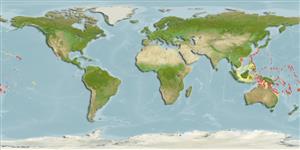>
Gobiiformes (Gobies) >
Gobiidae (Gobies) > Gobiinae
Etymology: Trimma: Greek, trimma, -atos = something crushed (Ref. 45335); kitrinum: Name from the Greek ‘kitrinos’, meaning ‘citron-yellow’ or ‘of citron’, referring to the distinctive yellow caudal fin of the new species..
Environment: milieu / climate zone / depth range / distribution range
Écologie
marin récifal; profondeur 1 - 36 m (Ref. 100726). Tropical
Western Pacific: Indonesia, Australia and certain island groups north to Guam, south-east to Fiji and Samoa.
Taille / Poids / Âge
Maturity: Lm ? range ? - ? cm
Max length : 2.7 cm SL mâle / non sexé; (Ref. 100726); 2.5 cm SL (female)
Description synthétique
Morphologie | Morphométrie
Épines dorsales (Total): 7; Rayons mous dorsaux (Total): 8; Épines anales 1; Rayons mous anaux: 8. This species (of Trimma tevegae group) is distinguished by the following characters: D VI + I,8; A I,8; pectoral-fin rays 13-14 unbranched; total gill rakers on the outer side of the first gill arch usually 20-22; 3-4 papillae in a transverse row at the posterior interorbital position of row p, and 3-5 papillae in a transverse row at the anterior position of row p; this transverse row usually extends anterior and lateral to the anteriormost papilla in row r; brownish body and bright yellow caudal fin, with no dark marking on the posterior part of the caudal peduncle (Ref. 100726).
Life cycle and mating behavior
Maturité | Reproduction | Frai | Œufs | Fécondité | Larves
Winterbottom, R. and D.F. Hoese, 2015. A revision of the Australian species of Trimma (Actinopterygii, Gobiidae), with descriptions of six new species and redescriptions of twenty-three valid species. Zootaxa 3934(1):001-102. (Ref. 100726)
Statut dans la liste rouge de l'IUCN (Ref. 130435)
Menace pour l'homme
Harmless
Utilisations par l'homme
Plus d'informations
Noms communsSynonymesMétabolismePrédateursÉcotoxicologieReproductionMaturitéFraiRassemblement de ponteFéconditéŒufsDéveloppement de l'œuf
Taille/ÂgeCroissanceLongueur-poidsLongueur-longueurFréquences de longueursMorphométrieMorphologieLarvesDynamique des populations larvairesRecrutementAbondanceBRUVS
RéférencesAquacultureProfil d'aquacultureSouchesGénétiqueElectrophoresesHéritabilitéPathologiesTraitementNutrientsMass conversion
CollaborateursImagesStamps, Coins Misc.SonsCiguateraVitesseType de nageSurface branchialeOtolithesCerveauxVision
Outils
Articles particuliers
Télécharger en XML
Sources Internet
Estimates based on models
Preferred temperature (Ref.
123201): 24.9 - 29.4, mean 28.3 °C (based on 1139 cells).
Phylogenetic diversity index (Ref.
82804): PD
50 = 0.5000 [Uniqueness, from 0.5 = low to 2.0 = high].
Bayesian length-weight: a=0.01023 (0.00477 - 0.02194), b=3.02 (2.84 - 3.20), in cm total length, based on LWR estimates for this (Sub)family-body shape (Ref.
93245).
Résilience (Ref.
120179): Haut, temps minimum de doublement de population inférieur à 15 mois (Preliminary K or Fecundity.).
Fishing Vulnerability (Ref.
59153): Low vulnerability (10 of 100).
